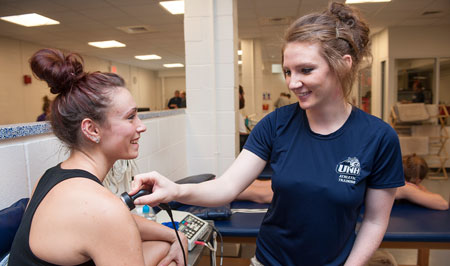
Orlaith Munnelly works with a hockey player to loosen tight muscles.
Dubliners may refer to soccer as “football” and the field on which it is played as a “pitch,” but such cultural differences aside, nothing beats being “pitchside” when the competition heats up. So say the three students from the Irish capital’s Dublin City University who are studying abroad at UNH this fall.
In most other countries, including Ireland, athletic trainers (ATs) see injured athletes only when they visit a clinic. “We don’t have as much time pitchside at home,” says Orlaith Munnelly from Wicklow, Ireland. “I enjoy it. We get to see a lot more. When an athlete is injured, they come to us right away. And, we can see how they progress from day to day.”
This past August, all three got an early introduction to college football – not soccer, but the American version.
“We’d seen American football in films, but it’s totally different to watch a real game,” says Rachael Yorke from Longford, Ireland.
“Football gets addictive,” says Mairéad Power, from Kilkenny, Ireland. “We love it and the athletic trainers for football love it, too. When the team wins, we feel like we’ve won as well.”
In addition to football, the three students will each have a stint with men’s and women’s ice hockey – also a new sport for them – women’s gymnastics, a less well-known sport, and women’s basketball, which they know very well.
Dan Sedory, director of the Athletic Training Program and the faculty member who oversees their experience, explains: “They’ve already completed all of their coursework. Their experience at UNH is a culminating clinical experience prior to the completion of their program, which includes a research component.”
At the gymnastics practice, Yorke, sitting alongside Sedory and other AT students, observes closely as one gymnast, just a few feet away, stretches, breathes deeply, then suddenly does a back flip to a handstand then springs back to her feet. It seems effortless.
Another gymnast consults with Sedory. “Today?” He responds quietly, “Let’s wait until next Thursday.”
She nods and walks through her floor routine, moving her arms, turning, and bending gently, vividly imagining the real thing. Even though she’s not 100 percent, she’s present and still a part of the team,
A few gymnasts have taped ankles – something the athletic trainers do prior to practice. From time to time, a gymnast will ask an AT, “Ultrasound?”
Sedory has noted that in Ireland, ATs don’t use as many devices such as ultrasound or electrical stimulation. Like ATs in most other countries, Irish ATs rely more on manual therapy techniques for treatment and rehabilitation. He adds that having these three Irish students demonstrate their techniques and approach has been valuable to AT students at UNH.
|
Perfection in gymnastics requires lots of training. Here Rachael Yorke treats a gymnast’s shoulder. |
Across campus, Munnelly observes a women’s ice hockey practice from the box next to the associate head athletic trainer. On the ice, players cycle across the ice with sticks waving and pucks flying across the ice.
Later that afternoon, Power accompanies ATs to a pregame football practice. A couple of players wear red shirts, clearly identifying them as injured and not ready to play. Power is very sympathetic. As a competitive athlete herself, she has experienced bruises and broken bones.
By working closely with experienced ATs, all three learn in “real-time” to be good clinicians and to understand aspects of prevention, evaluation, treatment, and rehabilitation. The goal is to facilitate an athlete’s healthy and safe return to play.
Growth of a Profession
As the founding president of the World Federation of Athletic Training and Therapy, Dean of the College of Health and Health and Human Services Mike Ferrara sees study abroad programs such as the one with DCU to be fundamental to the globalization of the profession. As a Fulbright scholar at DCU in 2010, Ferrara learned firsthand about their program and found that it was “top notch.” This year other DCU students are also studying at four other institutions in the U.S. UNH also has a study abroad agreement with the Institute of Technology at Carlow, Ireland.
“Athletic training is mostly a North American profession. Through the World Federation we established, after careful study, a mutual recognition agreement with Canada,” says Ferrara. “Our students can now take each other’s certification exams, and this allows for the beginning of the globalization of the profession.”
Related Links |
The World Federation’s World Congress has been held in the U.S., Canada, Scotland, and Japan. The next host will be Ireland, in September 2014, and DCU’s program is considered to be the leader in athletic therapy and training in all of Europe.
Meanwhile, back in Durham, Munnelly, Yorke, and Power have introduced UNH students to Irish sports such as Gaelic football and hurling. In fact, this fall Power flew back to Ireland for a weekend to compete in the national hurling playoffs, aka the Comogie. Over Thanksgiving, the threesome plans to see the sights in New York City, including, of course, the Statue of Liberty.
Originally published by:
UNH Today
-
Written By:
Staff writer | Communications and Public Affairs




















































